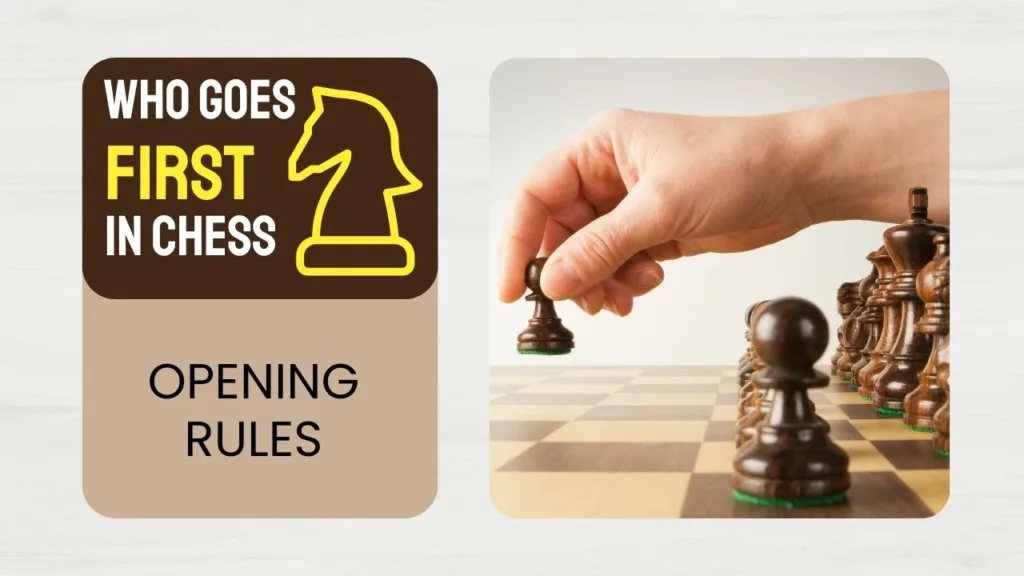If you’ve ever watched a chess game, you may have noticed something consistent: one player always moves first. But who gets that privilege, and why? In this short guide, we’ll explain everything you need to know about the first move in chess and what it means for the rest of the game.
So, Who Goes First?
In chess, the player with the white pieces always moves first. This rule is universal and applies to all formal games, from friendly matches to professional tournaments.
There’s no randomness to it once the pieces are assigned. If you’re playing with white, it’s your turn to go first. If you’re playing black, you wait and respond. Do you know that there are 20 possible first-moves for White?
Why Does White Go First?
The tradition of white moving first became standardized in the late 19th century. Before that, players could decide who moved first by agreement, coin toss, or even alternating in matches.
The modern rule – White always moves first – was adopted for consistency and fairness. It also makes game notation (recording moves) clearer.
Is It an Advantage to Move First?
Yes, at least a slight one. To put it in perspective:
- If a pawn is worth 1 point,
- and a queen is worth 9 points,
- then having the first move gives White an advantage of about 0.3 points.
It’s not overwhelming, but it’s enough to matter, especially at the highest levels of play. That small edge allows White to seize the initiative and shape the early direction of the game.
Statistically, White has a better winning percentage than Black, especially in high-level games. Going first allows White to:
- Seize control of the center early
- Dictate the pace of the game
- Set the tone with opening strategy
However, this doesn’t mean Black is doomed. Some of the most solid and creative strategies come from playing as Black, especially for players who like to counter-attack.
How Do You Decide Who Gets White?
In casual games, you can decide any way you like:
- Flip a coin
- Hide a pawn in each hand: white in one, black in the other
- Alternate colors if playing multiple games
- Let someone pick randomly
In tournaments, the organizers assign colors using pre-set pairings to ensure fairness over multiple rounds.
What Are Common First Moves?
Once you’re playing as White and it’s your move, what should you play?
Some of the most popular first moves include:
- 1.e4 – King’s Pawn Opening: Fast development and open play
- 1.d4 – Queen’s Pawn Opening: Solid and strategic
- 1.Nf3 – Reti Opening: Flexible and modern
- 1.c4 – English Opening: Aimed at controlling the center from the side
These are just the beginning of countless opening systems you can explore.
(See our articles: The 10 Most Popular Opening Moves in Chess, Ranked From ‘Why?’ to ‘Wow!’.)
What If You’re Playing Chess960?
In Chess960, also known as Freestyle Chess, the back-rank pieces are randomized. However, White still goes first, just like in classical chess. Even with the wild variety of starting positions, the rule of White moving first never changes.
Is It Racist That White Always Goes First in Chess?
This question comes up from time to time: “If White always moves first in chess, isn’t that racist?” It’s a fair concern in a world that’s becoming more aware of how traditions can reflect or reinforce deeper biases. But no, the rule Is Not Racist. Here’s Why:
The rule that White goes first in chess has nothing to do with race or skin color. It refers only to the color of the pieces, which are often white and black for contrast and visibility.
The choice of colors is practical and aesthetic, not symbolic. Chess sets can come in many colors: ivory vs brown, light vs dark wood, red vs green, but the lighter-colored pieces are always designated “White” and the darker ones “Black” for clarity.
The decision for White to move first became standardized in the 1880s for consistency in tournaments and record-keeping, not as a social or political statement.
Summary: Who Goes First?
| Rule | Explanation |
|---|---|
| White moves first | Always, in all chess formats |
| Advantage | Slight edge to White due to initiative |
| Deciding colors | Random or alternating in casual play; assigned in tournaments |
| Chess960 | White still goes first despite randomized setup |
Your Next Steps
If you’re just starting out in chess:
- Practice as both White and Black to build versatility
- Learn key openings for both colors
- Don’t worry too much about the “first move advantage”, what matters more is what you do after
Want more beginner-friendly guides? Check out our growing library at AttackingChess.com to sharpen your skills, one move at a time.

I’m Xuan Binh, the founder of Attacking Chess, and the Deputy Head of Communications at the Vietnam Chess Federation (VCF). My chess.com and lichess rating is above 2300. Send me a challenge or message via Lichess. Follow me on Twitter (X) or Facebook.

